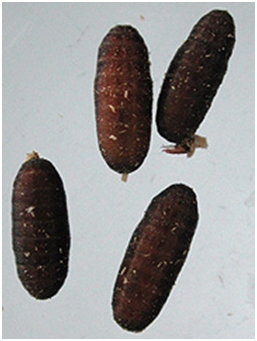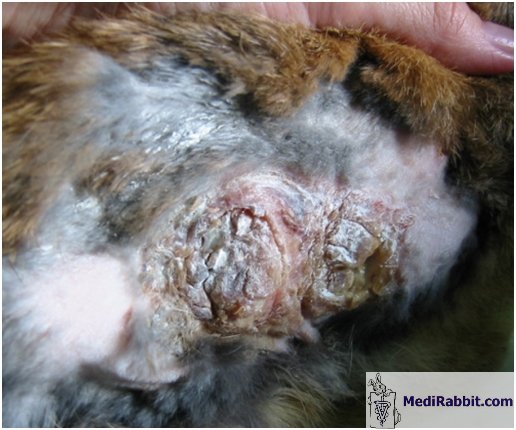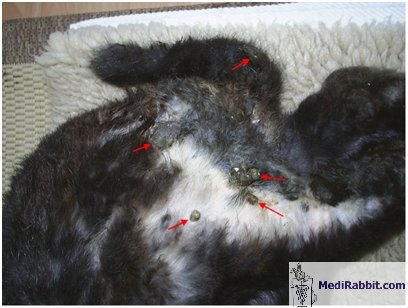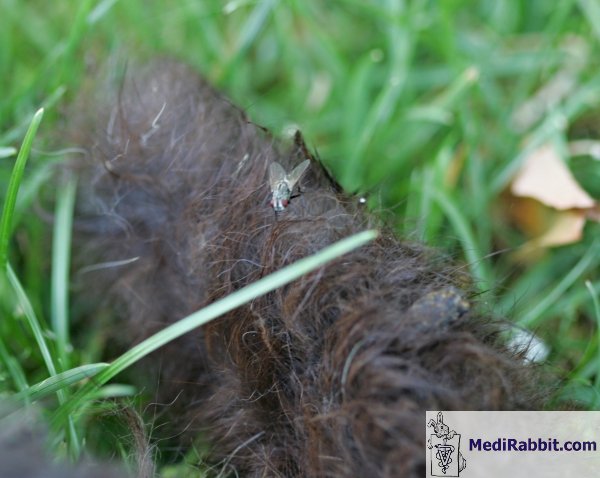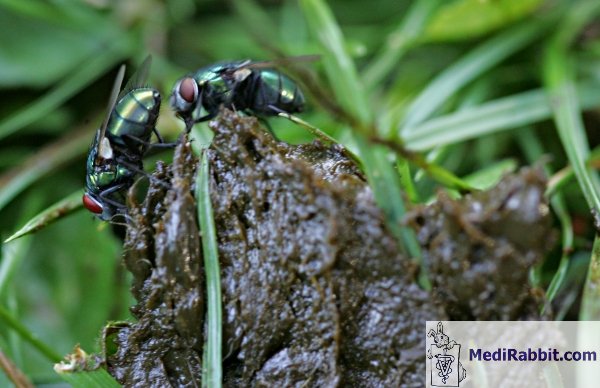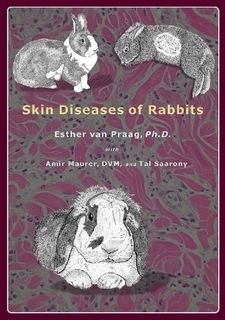Myiasis
(fly-strike) in Rabbits
Esther van Praag Ph.D.
MediRabbit.com is
funded solely by the generosity of donors.
Every
donation, no matter what the size, is appreciated and will aid in the
continuing research of medical care and health of rabbits.
Thank you
|
Warning: this file
contains pictures and videos that may be distressing for people.
Myiasis, also called fly-strike,
is more frequently observed during the hot humid summer months. It is caused
by several kinds of insects that lay their eggs in the wounded skin of
mammals. Rabbits suffer in particular from the blowflies Lucilia sericata,
Calliphora sp., the grey flesh fly Wohlfahrtia sp., the common
screwworm fly Callitroga sp., and from the botfly Cuterebra sp,
which is seen in the USA only. A maggot attack is often linked to poor
hygiene, with rabbits kept on litter soiled with urine and excrements, or
poor-cleaned litter pans, but can also relate to health problems. A
particular attention must also be given to rabbits suffering from dental
(malocclusion, removal of incisors) or digestive diseases, from obesity,
untreated infected wounds, or that are disabled (fracture of the spine, limb,
arthritis, spondylosis). Indeed, the inability to groom the perianal and tail
regions, or eat their cecotropes feces can lead to the appearance of a smell
that will inevitably attract flies.
Myiasis flies lay eggs in the
skin soiled with feces or diarrhea, on skin irritated by urine or in
untreated infected wounds. The larvae that emerge from the hatched eggs will
immediately start burrowing themselves through the skin, into the flesh of
the host animal. A consequence is septicemia and shock, which lead to the
rapid death of the rabbit.
The
use of prophylactic solutions is not recommended as adverse fatal effects
have been observed in rabbits (Frontline). Some veterinary professionals use
the prophylactic product Dicyclanil (Novartis), which protects sheep against
the blowfly Lucilia sp. The product is not registered for use in
rabbits, and a safe use in rabbits can thus not be guaranteed. Clinical signsThe
early stages of myiasis are often subclinical. With time, a rabbit becomes
depressed, weak, loses weight and shows paresis. At this stage, the infection
becomes visible; the larvae are about 1 cm long and their hind part
protruding from the respiratory hole (spiracle) in
the skin.
In
a severe case, alopecia is observed. The skin is inflamed, injured with signs
of necrosis, and is often accompanied by the smell of ammonia. The later is
excreted by the larvae, in order to cause cell death
and decomposition, will cause an intoxication of the rabbit.
Aberrant migration of the larvae
is possible. Migration into the trachea has been observed. This leads to the
formation of a laryngeal edema, blocking the air supply to the lungs. It may
be accompanied by concurrent accumulation of mucus and swelling of the
esophagus.
Diagnosis
The history of the rabbit and the
clinical signs are generally sufficient for a proper diagnosis.
Treatment
The hair is delicately clipped away around the infected area and each
larva is removed individually and entirely with the aid of forceps, without
crushing it, to prevent skin irritation or the development of an allergic
reaction. The wounds are cleaned with a sterile saline solution, an
antiseptic solution (e.g. povidone-iodine or chlorhexiderme). There is no
need to use an insecticidal solution, if all the maggots have been removed.
• Injection of ivermectin (0.4 mg/kg, SC). The
rabbit must be closely monitored as the dying larvae excrete a toxin that can
be fatal to animals, including rabbits. Although controversial,
corticosteroids are sometimes given to the affected animal, in order to
reduce the swelling. • Injection of doramectin (0.5 mg/kg, SC). • Surgical removal, under anesthesia, in case of
aberrant migration or infection by Cuterebra sp.. Use of antibiotics is indicated, if the myiasis infection is severe.
They help fight a secondary bacterial infection of the wounds and prevent
sepsis, which can be fatal in rabbits. The administration of non-steroidal pain medication is necessary (e.g.
meloxicam, carprofen). When the affected rabbit has stopped to eat, it must be hand-fed and
given SC fluid therapy, in order to avoid the onset of fatal hepatic
lipidosis and dehydratation. Depending on the situation, the affected rabbit
can furthermore be administered appetite stimulants, or gut motility
medication (e.g. cisapride, metoclopramide). Bathing the rabbit with antiseptic or insecticide solution is not
indicated. This procedure is stressful for the rabbit, and often ends in a
panic reaction as soon as the fur is wetted or death by heart-arrest. A jump
out of the bathtub has led to broken limbs or fracture of the spinal cord. If
this method is nevertheless chosen, the rabbit should be dried with a towel
and a hair-dryer or placed under a heat lamp. The heat will indeed bring the
remaining worms to the surface of the skin, from where they can be easily
discarded. If a rabbit is heavily affected by myiasis,
euthanasia should be considered. Prevention of myiasis can be done
by addressing the causes of fecal or urine contamination of the skin, and by
keeping the rabbit in a clean hygienic environment. Daily inspection of the
perianal region is necessary in rabbits prone to suffer from digestive disorders,
that are obese or that are disabled. The fur should be combed with a
flea-comb, in order to detect the eventual presence of eggs and/or maggots.
The windows of the apartment or the cage of the rabbit can furthermore be
covered with a mosquito net, in order to avoid the insects to have contact
with the rabbit. For detailed information on fly strike infestation
in rabbits, see: “Skin Diseases of Rabbits” by E. van Praag, A. Maurer and T.
Saarony, 408 pages, 2010. Acknowledgement
Many thanks to Kerry Su-Lin Leow (Singapore) for
sharing her pictures. Further ReadingsBaird CR. Biology of Cuterebra lepusculi Townsend (Diptera:
Cuterebridae) in cottontail rabbits in Idaho. J Wildl Dis.
1983;19(3):214-218. Harcourt-Brown F.: Textbook of Rabbit Medicine. 1st ed.,
Butterworth-Heinemann, Oxford, England, 2002. Hess L. Dermatologic diseases. In: Ferrets Rabbits and Rodents.
Clinical Medicine and Surgery, 2nd ed., (Quesenberry K.F., Carpenter J.W.)
Saunders, St-Louis, USA., 2004. Jacobson HA, McGinnes BS, Catts EP. Bot fly myiasis of the cottontail
rabbit, Sylvilagus floridanus mallurus in Virginia with some biology
of the parasite, Cuterebra buccata. J Wildl Dis. 1978;14(1):56-66. Newell GB. Dermal myiasis caused by the rabbit botfly (Cuterebra sp). Arch Dermatol.
1979;115(1):101. Schumann H, Schuster R, Lange J. The warble fly Oestromyia
leporina (Diptera, Hypodermatidae) as a parasite of the wild
rabbit (Oryctolagus cuniculus). Angew Parasitol. 1985;26(1):51-52. Weisbroth SH,
Wang R, Sacher S. Cuterebra buccata: immune response in myiasis of domestic
rabbits. Exp Parasitol. 1973; 34(1):22-31. |
e-mail: info@medirabbit.com





